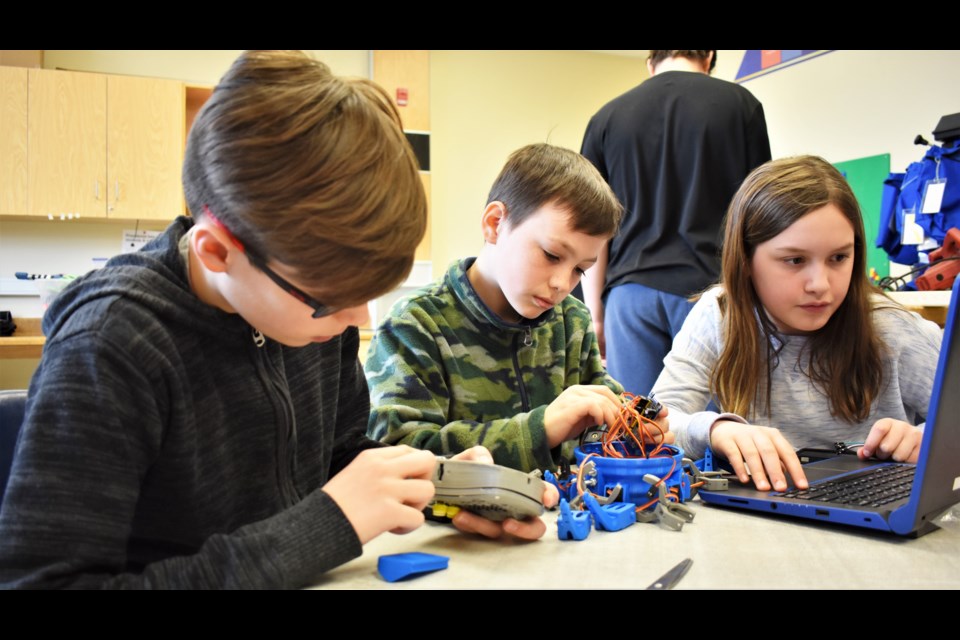“So, what did you do at school today?”
At some dinner tables, that question might prompt an eye-roll or a yawn, but for students who participate in the STEAM program at Harriett Todd Public School, that query will likely produce some unexpected answers.
You might, hear, for example: “We made a prosthetic thumb!” “We built a robot!” “We worked on our new video game.”
When you step inside Christopher Rutledge’s Science, Technology, Engineering, Art and Math (STEAM) lab, you will not find a “traditional” classroom. In this room, students in grades four through eight are abuzz as they work both independently and together on a variety of projects they have, essentially, developed.
Connor Eastcott and Kayla Brockbank, two Grade 8 students, have worked on a particularly interesting project in recent weeks. With the help of Rutledge, a technology teacher at Harriett Todd, they joined an online community called Enabling the Future and, using their in-class 3D printing and design technology, created a prosthetic thumb for Wyevale’s Bill Wilson.
Wilson came to the school last week to see his new artificial appendage – and for a fitting. He was “blown away” by what the students created.
“As soon as I saw it, I just couldn’t believe it,” Wilson told OrilliaMatters. “It makes me very happy.”
About 13 months ago, Wilson was using a table saw to cut some laminate flooring and as he was pushing the piece through the blade, his thumb was severed. “I heard it before I felt it and then I couldn’t find it,” said Wilson.
He was fortunate. A co-worker helped him find the thumb and it was reattached during surgery at a Toronto hospital. But it is much shorter than it once was and he does not have full use of the critical appendage.
“This gives me the length I need and the support and protection,” he said of the new prosthesis. “I so appreciate what they’ve done.”
It did not happen overnight. Rutledge said it was a long and involved process to become an official chapter of Enable. However, it was worthwhile. The founder of Enable connected Harriett Todd students with a bioengineering student at the University of Pittsburgh who helped them through the process.
“We’ve done several video chats with him, he has given us advice and helped as we took measurements and made adjustments,” said Rutledge. “It’s been a very educational process.”
It’s also been gratifying, said Brockbank.
“it’s almost surreal to think that we have the ability to help out people,” she said. “The fact that we can give someone that ability, per se, it feels really great. I like to help others, so this is pretty amazing for us.”
What is also pretty amazing is that all the work on projects in the STEAM lab are done on the students’ own time and under the supervision of Rutledge, who also gives up his ‘free’ time for the project.
“This is when I’m supposed to be eating, so usually you’ll find me stuffing something into my mouth,” quipped Rutledge, noting STEAM is, essentially, an extra-curricular activity that is available during lunch and, at times, after school. “It depends on what I’m coaching.”
While it is a lot of work and a huge commitment, Rutledge said he has a passion to tap into the creativity of students. It’s a passion borne from his own experience; he struggled with writing and spelling as a youngster.
But he loved technology and was one of the first to brave the new frontiers of Facebook and MSN Messenger – especially when he was overseas. “Having that ability to communicate really sparked an interest in technology for me,” he said. “So, when I started going through Teachers College, I always gravitated toward Smart Boards and different ways to deliver curriculum that could be engaging for my students.”
With the support of principal Marg Moran and assistance from the school board, Rutledge has found a way to open up new frontiers for today’s generation of students. There are kids in his class using 3D printing to create prosthetics, some are developing computer games, while others work on a prototype for a new and improved Gameboy-type device and others build robots.
“I’ve always had this belief that if a kid has an interest in it, we should embrace it as a vehicle to deliver different ideas,” he said, noting the students drive the projects. “Whatever they’re into, I’m trying my best to facilitate, to teach and learn the skills right along with them.”
He said he’s “trying to tap into their passions and use skills they learn in other classes in math and language to create something, to build something, to do something they didn’t think possible.”
A tangible example of that is the arcade machine the class built last year – with the help of woodworking students at Twin Lakes Secondary School. It was something fun that galvanized the group and proved to them that they could do something exceptional, said Rutledge.
“This is where they can come and create,” he said of the bustling STEAM lab. “At school, it feels sometimes like you practice a lot and don’t play the game. I find in this environment, they get to actually create, make something tangible and, at the end of the year, they can look back and say ‘I made this’, ‘I created this.’”
And it’s not all computer-driven, he noted. “A couple of our students want to launch a watermelon with a catapult and I say, ‘OK, how we do that?’ It’s about doing the research, asking for resources … and working together. Anything is possible!”



